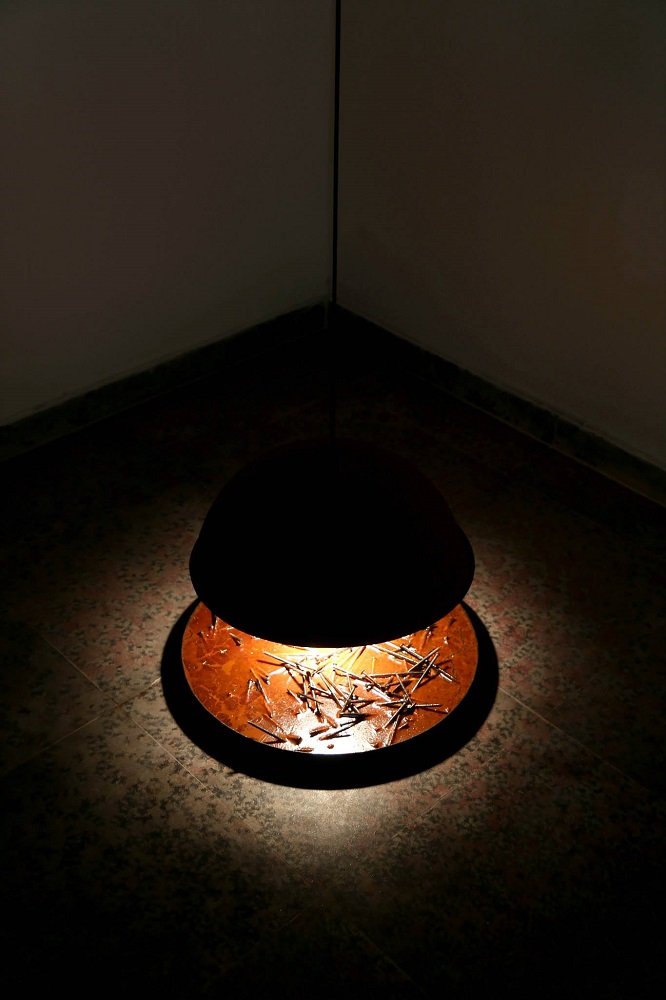The Science of Taking a Walk: Navigating / Re-,navigating - Forming Trajectories' opened Thursday 21st May at Gandhara-Art Space. The show, curated by
The Science of Taking a Walk: Navigating / Re-,navigating – Forming Trajectories’ opened Thursday 21st May at Gandhara-Art Space. The show, curated by Haajra Haider, features the works of nine contemporary artists and a publication as a parallel component to the exhibition, which contains the writings of six individuals. The contributors who hail from various disciplines – an art critic, writer, archivist, architect, cartographer and filmmaker – were invited by the curator to respond to the curatorial note.
The gallery was mapped out through a colour-coded chart with each artist assigned their own colour. This helped in navigating the space and also formed a formal connection with the concept the show was built around, as explained by the curators note:
“The artist’s curiosity often takes her to navigating unknown paths or (re)navigating known ones. The trajectory formed is one that varies with the artist’s observations and interests. Physical aspects of a space, or cultural mannerisms – what is it that clicks with the artist and becomes a point of departure and entry. Foreign lands or personal domains can both be challenging in this regard. Personal domains maybe even more so, since unlearning or disregarding certain knowledge and habits maybe required in order to start afresh. How are these personal trajectories then translated so that glimpses of the artist’s experiences are made available to be experienced by the viewer? Is the viewer able to see through the lens of the artist and relate to, recognize, and associate with her experience?”
Omer Wasim’s untitled work – nails submerged in a metal container filled with water – sits under a glow of light, slowly rusting away. Wasim manages to find aesthetics in these common objects, manipulating them to forge a deeper meaning or connection. One cannot help but stare at the artwork, trying to draw up an infinite number of conclusions as to what the work is meant to express. Moving further on, Wasim brings us a wall of pages. The pages feature stark white blank spaces, as if portions of a story have been wiped out, and leaving us with only the text the artist wishes for us to read, forming a personal story line that the reader is made privy too.
On the other end of the hall, passport photographs scanned and printed in large dimensions cover the walls of the gallery. Shalalae Jamil’s work explores portraiture with photography being the artist’s medium of choice. A portrait can be a fascinating means of identifying with an individual. It depicts an untold story, piques curiosity and forms a sense of association with the subject.
Naiza Khan’s Rear-view featuring black and white photography and text evokes a sense of nostalgia, the notes undecipherable, the artwork looks like a piece of framed fuzzy memories – a certain point in time captured and frozen.
Fazal Rizvi’s typewriter drawings, in the artist’s own words, stem from his musings about the sea while thinking about the shrinking space of existence and being otherwise. It resulted in drawings referencing urban landscapes from Karachi. These have been done using only a typewriter, as if to be able to communicate through signs and not words.
On the far end of the wall sits an illusion. Using digital print on vinyl, Seema Nusrat and Seher Naveed create an extension of the gallery space itself, titled False Perspective.
Bani Abidi’s well-known video Mangoes, plays on a small TV screen. The video features two women, one Indian the other Pakistani in conversation about mangoes. Both the women are played by Abidi herself. The video explores the dynamics of the two nations.
Kahani Eik Shehr Ki by Farida Batool, takes us alongside the artist for a walk among the city streets. What’s interesting about this piece is its interactive quality; your pace determines your visual reception. It gives you a true sense of the city streets, evoking familiarity.
In a corner sits a table with a small well-lit lamp placed upon it. The table top is strewn with photographs and a page full of text. Yaminay Chaudhri’s An Imaginary Walk on Seaview (things emerging from the sand, and sinking back in) features an ode to Karachi’s sandy attraction, a haven for city dwellers to escape to. Chaudhri’s photographs taken from a cell phone are images of found objects at the beach printed on photo paper.
The exhibition was well received; it is an invitation into an artist’s own reflections on the spaces that encapsulate him or her, blurring borders and outlining new ones. The exhibition will continue until the 25th of July.
‘The Science of Taking a Walk’ is on view at Gandhara-Art Space, Karachi, from 21 May – 25 July 2015. Images courtesy Gandhara-Art Space.

COMMENTS